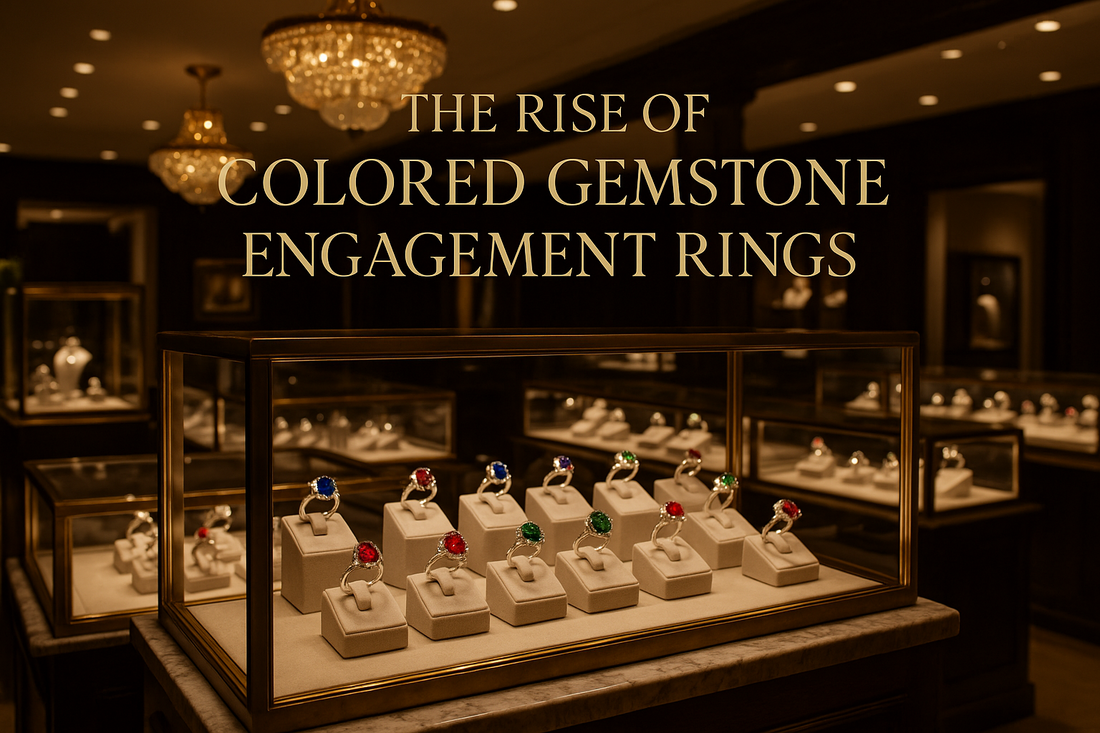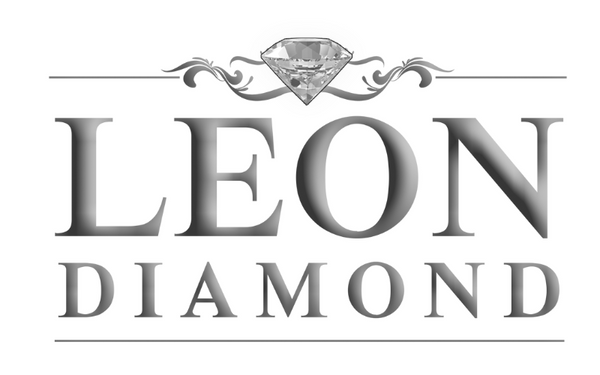
The Rise of Colored Gemstone Engagement Rings
Share
Colored gemstone engagement rings are a growing trend in the jewelry industry, shifting away from traditional diamond rings to more vibrant and unique alternatives. This movement has been driven by shifts in consumer preferences, increased awareness of ethical sourcing, and a growing demand for more personalized diamond jewelry options.
According to a 2023 survey conducted by the Jewelers of America (JA), nearly 40% of engagement ring buyers now opt for gemstones other than diamonds, such as sapphires, emeralds, and rubies, reflecting a significant shift in purchasing behavior. This trend signifies not only a change in consumer taste but also an emerging focus on sustainability and individuality in the selection of engagement rings.
In this article, we will explore the rise of colored gemstone engagement rings, their historical significance, and the reasons behind their increasing popularity. We will delve into various types of gemstones, ethical considerations in their sourcing, and provide insights into why these rings are becoming a preferred choice for modern couples.
What Are Colored Gemstone Engagement Rings?
Colored gemstone engagement rings feature a variety of colorful stones like sapphires, emeralds, rubies, and more, instead of traditional diamonds. These rings offer more color options and personalized styles, making them unique.
Why Are More Couples Choosing Colored Gemstones Over Diamonds?
- Changing Consumer Preferences: A shift toward individuality and more unique choices, with colored gemstones allowing for a more personalized touch.
- Symbolism and Meaning: Different colored stones carry their own cultural and emotional significance, making them ideal for couples seeking a more meaningful engagement ring.
Types of Colored Gemstones
- Sapphires: Popular for their durability and range of colors, especially blue.
- Emeralds: Known for their vivid green color and association with rebirth and love.
- Rubies: Valued for their deep red hue, representing passion and vitality.
- Other Gemstones: Aquamarine, morganite, amethyst, garnet, and spinel, offering diverse color palettes and meanings.
Why Are Colored Gemstone Engagement Rings Becoming More Popular?

Several key factors explain why colored gemstone engagement rings are gaining traction:
- Personalization: Couples are increasingly looking for rings that reflect their individuality. Colored gemstones offer an array of options to match personal tastes.
- Celebrity Influence: High-profile figures, such as Kate Middleton and Meghan Markle, have popularised coloured gemstones, influencing engagement ring trends.
- Ethical and Sustainable Practices: Many colored gemstones are marketed as more ethical and sustainable, appealing to consumers concerned about conflict diamonds. According to the Gemological Institute of America (GIA), ethical sourcing is a significant factor influencing purchasing decisions.
- Affordability: Colored gemstones can be more affordable than diamonds, making them an attractive alternative for couples with a set budget.
- Cultural Significance: Gemstones like sapphires, emeralds, and rubies hold cultural and historical significance, which makes them even more meaningful in an engagement ring.
Popular Colored Gemstones for Engagement Rings
Several colored gemstones are commonly used in engagement rings, each offering unique characteristics. The rise in popularity of colored gemstones has led many consumers to consider alternatives to diamonds.
Sapphire:
- Hardness: 9 on the Mohs scale, making it highly durable.
- Color: Available in various colors, including blue, yellow, green, and pink.
- Symbolism: Represents wisdom, loyalty, and nobility.
- Celebrity Influence: Princess Diana and Kate Middleton’s iconic sapphire rings have significantly influenced the popularity of this gemstone.
Emerald:
- Hardness: 7.5–8 on the Mohs scale.
- Color: Known for its vivid green color, which symbolizes rebirth, fertility, and love.
- Symbolism: Widely associated with royalty and wealth.
- Popularity: Frequently used in vintage and historical engagement rings.
Ruby:
- Hardness: 9 on the Mohs scale, offering durability similar to sapphire.
- Color: Deep red, representing love, passion, and energy.
- Symbolism: Known for its strong emotional significance.
- Value: Highly valued for its deep color and rarity.
Aquamarine:
- Hardness: 7.5–8 on the Mohs scale.
- Color: Pale blue, symbolizing tranquility and calm.
- Popularity: Ideal for those seeking a subtle, calming stone with significant meaning.
Morganite:
- Hardness: 7.5–8 on the Mohs scale.
- Color: Pink to peach, symbolizing compassion and love.
- Affordability: Gaining popularity due to its romantic tone and reasonable price point.
The Ethical Implications of Colored Gemstone Sourcing
With the increased demand for colored gemstones, ethical sourcing practices have become critical to ensure that gemstones are mined responsibly.
Conflict-Free Sourcing:
Colored gemstones should be sourced from conflict-free regions to avoid supporting unethical practices. The U.S. Department of State has established regulations for gemstone sourcing to prevent human rights abuses.
Fair Labor Practices:
Many gemstones, especially from developing countries, may be tied to exploitative labor practices.
Environmental Impact:
The extraction of gemstones can lead to significant environmental damage, especially when mining practices are unsustainable. Programs like Fairmined certification ensure that gemstones are mined in an eco-friendly manner.
Economic Impact of the Colored Gemstone Trend

The rise in demand for colored gemstones has had a substantial economic impact, particularly in the diamond jewelry sector.
Market Growth:
The colored gemstone market is projected to grow by 5-7% annually over the next decade, reflecting an increasing consumer interest in alternative engagement ring options.
Rising Consumer Interest:
A report by the American Gem Trade Association (AGTA) found that engagement ring buyers are increasingly opting for coloured stones over diamonds, resulting in a shift in market dynamics.
Competition Among Jewelers:
Jewelers are investing in sourcing and marketing colored gemstones, offering a variety of options, including custom engagement rings, to meet growing demand.
Choosing the Right Colored Gemstone for Your Engagement Ring
When selecting a colored gemstone, several factors must be considered to ensure that the stone is suitable for an engagement ring:
Durability:
- Sapphires and Rubies: Known for their exceptional durability (9 on the Mohs scale), these are ideal for daily wear.
- Emeralds: Slightly softer (7.5-8 on the Mohs scale) and may require extra care to prevent damage.
Color:
- The color of the gemstone is crucial, as it will determine the overall appearance of the engagement ring.
- Sapphires come in various colors, including deep blue, pink, yellow, and even green.
Cut:
The cut of the gemstone determines its brilliance and sparkle. A well-cut gemstone will reflect light beautifully, adding to the aesthetic appeal of the ring.
Clarity:
While higher clarity stones are more valuable, many gemstones, such as sapphires and emeralds, are appreciated for their natural inclusions, which add character to the stone.
The Future of Colored Gemstone Engagement Rings
As the trend for colored gemstones continues to grow, there are several factors shaping the future of this market:
Sustainability and Ethical Sourcing:
With increasing consumer demand for ethically sourced gemstones, the market will likely see more initiatives focused on sustainability, fair trade, and transparent sourcing practices.
Innovative Designs:
Jewelers will continue to innovate, offering new and creative designs for engagement rings. Colored gemstones provide more opportunities for unique customization.
Increased Popularity:
As more couples seek alternatives to diamonds, colored gemstones will continue to be a popular and prominent choice for engagement rings.
Discover Your Perfect Colored Gemstone Ring

Choosing a colored gemstone engagement ring is more than a style decision—it’s a statement of individuality and timeless love. From the regal depth of sapphires to the vibrant energy of emeralds and the passionate glow of rubies, each gemstone tells its own unique story. These rings not only stand out for their beauty but also carry cultural and symbolic meanings that have been cherished for centuries.
At Leon Diamond, we believe your engagement ring should be as exceptional as your relationship. That’s why our curated collection offers ethically sourced, high-quality gemstones, crafted into designs that balance tradition with modern sophistication. Our team of expert jewelers works closely with you to ensure your ring reflects your personal taste, lifestyle, and vision for the future.
Frequently Asked Questions
What is the most popular colored gemstone for engagement rings?
Sapphire is the most popular colored gemstone for engagement rings due to its durability, variety of colors, and symbolic significance. Blue sapphires, in particular, are the most common choice.
Are colored gemstone engagement rings more affordable than diamonds?
In many cases, colored gemstones are more affordable than diamonds, especially for stones like aquamarine, morganite, and amethyst. However, prices vary depending on the type of gemstone, size, and quality.
How do I care for a colored gemstone engagement ring?
Colored gemstone engagement rings should be cleaned regularly using a soft cloth, mild soap, and water. Avoid exposing gemstones to harsh chemicals or physical stress, especially softer stones like emeralds.
Are colored gemstones as durable as diamonds?
While diamonds are the hardest gemstones (10 on the Mohs scale), many colored gemstones, like sapphires and rubies (9 on the Mohs scale), are also highly durable and suitable for daily wear. However, softer stones like emeralds (7.5–8 on the Mohs scale) may require extra care.
Can colored gemstone engagement rings be resized?
Yes, colored gemstone engagement rings can be resized, but care must be taken depending on the gemstone. Some stones, like emeralds, may be more prone to cracking during resizing.
